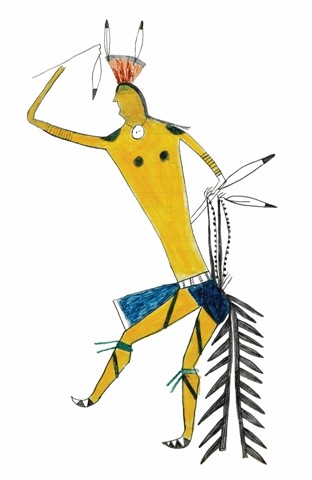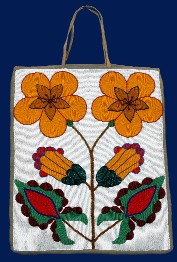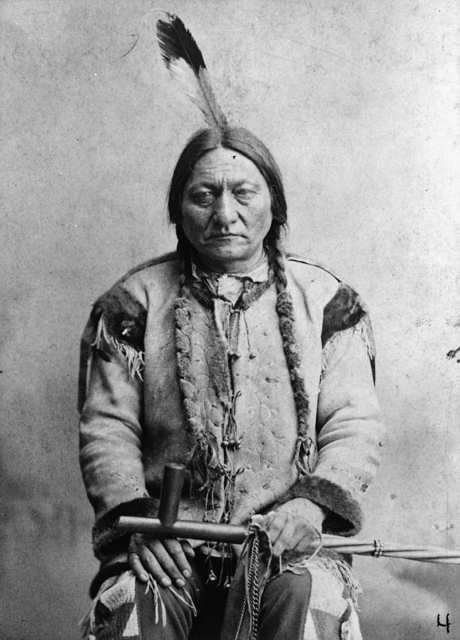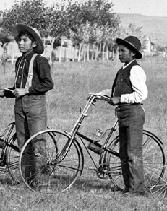Indian Education for All Resources
Approximately one-third of the grades 4-6 curriculum, Montana: A History of Our Home, is IEFA-related. Indian history and culture is also integrated into almost every chapter of the middle-school textbook, Montana: Stories of the Land. Chapter 2 - People of the Dog Days, Chapter 3 - From Dog Days to Horse Warriors, Chapter 7 - Two Worlds Collide, and Chapter 11 - The Early Reservation Years are particularly focused on Montana Indian history.
Additional Indian Education for All Lesson Plans and Resources
Learn more about Montana history, native cultures, and artistry and introduce primary sources (including art, photographs, and documents) into your classroom through these lessons, while providing your students insight into the Essential Understandings regarding Montana Indians.
Montana's First Peoples (Designed for grades 4-6). In this unit students will investigate Montana's earliest history from 12,500 years ago to about 1810 while practicing Common Core skills. They will explore the unique history and cultures of some of Montana's tribes through art, oral histories, and music. They will discover that there are different ways of learning about the past, including oral traditions and archaeology. Finally, they will make connections between the physical environment, material culture.
Who Are the Little Shell? (Designed for grades 6-8) is a large (17 day) unit that cover the history of the Anishinaabe, the McCumber Commission and the 10-Cent Treaty, Chief Little Shell, the buffalo economy and Red River carts, the Landless Indians of the twentieth century, and the fight for federal recognition. It also answers the questions “Who are the Métis” and introduces students to the Métis Archipelago. The unit can be taught in its entirety, but each subtopic can also be taught independently. Former classroom teacher Anna East and Montana current poet laureate and Little Shell tribal member Chris La Tray created the unit for the Indian Education Division of the Montana Office of Public Instruction.
Resources Commemorating the 150th Anniversary of the Marias Massacre (high school). To recognize and remember the tragedy of the Marias Massacre, Montana The Magazine of Western History has made available an article on the event as well as discussion questions for classroom use. Also included on this page are links to a primary source based lesson plan and other information.

Virtual Tour: Neither Empty nor Unknown: Montana at the Time of Lewis and Clark (4-8) Based on an interactive tour given at the Montana Historical Society Museum, this virtual tour uses PowerPoints to bring the exhibit into your classroom. Also included in this lesson plan are post-tour lessons and discussion questions. If you are able to bring your class to the exhibit, you can find pre and post-tour lessons as well as a preview of the tour here.
The Art of Storytelling: Plains Indian Perspectives (K-12). These materials are designed to provide you and your students with an exciting way to incorporate Indian Education for All into your art curriculum. The material includes grade-appropriate lesson plans which are aligned with the Essential Understandings and the Montana Art Content Standards; three PowerPoint presentations, one focused on winter counts and two about ledger art (one of which is designed for grades K-6 and the other for grades 7-12); and additional material that explores winter counts and biographical art.
"Poems for Two Voices," recommended for grades seven through twelve, is a two- to three-day lesson that uses the same documents featured in "Hearing Native Voices: Analyzing Differing Tribal Perspectives in the Oratory of Sitting Bull and Plenty Coups." After analyzing Plenty Coups' and Sitting Bull's rhetoric, student pairs will write a poem for two voices, comparing and contrasting the tribal leaders' perspectives, gaining a better understanding of Essential Understanding regarding Montana Indians #1: "There is great diversity among the twelve tribal nations of Montana in their languages, cultures, histories and governments."
“Russell on Indians” (grades 7–12) explores the topic of stereotypes, especially about Indians. After class discussion, students will examine several Russell paintings during a “gallery walk” to explore how the artist did and did not reinforce Indian stereotypes.

A Beautiful Tradition: Ingenuity and Adaptation in a Century of Plateau Women's Art (Designed for 4th-12th) These materials are designed to provide you and your students with an exciting way to study this colorful art form while incorporating Indian Education for All in your classroom. There are three grade-appropriate versions of this curriculum: fourth/fifth grade, middle school, and high school. These interdisciplinary units include grade appropriate lesson plans, aligned with the Essential Understandings; PowerPoint presentations; worksheets; and other material that explores this remarkable art form.
Resilience: Stories of Montana Indian Women This booklet collects essays originally written for the Montana Women's History website and later published in Beyond Schoolmarms and Madams: Montana Women's Lives (Montana Historical Society Press, 2015.) It is a useful companion to the lesson Ordinary People Do Extraordinary Things.
Ordinary People Do Extraordinary Things! Connecting Biography to Larger Social Themes Lesson Plan (Designed for grades 8-12) This lesson uses essays published on the Montana Women’s History website to help students explore how ordinary people’s lives intersect with larger historical events and trends and to investigate how people’s choices impact their communities. After analyzing two essays on American Indian women from the Women’s History Matters website, students are asked to conduct interviews with people in their own community to learn about how that person has chosen to shape the world around him or her.
"Sun Dance in Silver Bow: Urban Indian Poverty in the Shadow of the Richest Hill on Earth" is a PowerPoint-based lesson plan that explores the complexity underpinning the change-over (or reconfiguration) of the West (and particularly Montana) from Aboriginal lands into Euro-American hands at the end of the nineteenth century.
"Who Are the Metis?" (Designed for grades 3-6) This PowerPoint lesson plan introduces the Métis, an important Montana cultural group with roots in the fur trade.
Recognized at Last: The Little Shell Chippewa (Designed for grades 5-12) This 30-50 minute PowerPoint lesson provides a brief introduction to the Little Shell Chippewa and their fight for tribal recognition.
Making an Atlatl (Designed for grades 4-8, adaptable to high school) provides detailed instructions on how students can make atlatls and darts while learning more about the physics behind this ancient technology and the tremendous skill it took to hunt large games in the pre-contact era.
"Native American Trade Routes and the Barter Economy" includes two learning activities intended to complement Chapter 2 of the Montana: Stories of the Land textbook. Designed for use in grades seven through nine, Activity One, "Resources and Routes," focuses primarily on mapping pre-contact trade routes, with a special emphasis on Montana. Activity Two, "Trading Times," asks students to simulate the process through which various products from different regional tribes were bartered and disseminated to gain a better understanding of pre-contact barter economy and how it compares with the modern-day cash economy.
"When Worlds Collide: The Salish People Encounter the Lewis and Clark Expedition" is a flexible one- to four-day learning activity designed to complement Chapter 4 of the Montana: Stories of the Land textbook. Recommended for use in grades seven through nine, the activity challenges students to grapple with historical evidence and to better recognize the complexity of native-white encounters.
"Blood on the Marias: Understanding Different Points of View Related to the Baker Massacre of 1870" is a flexible one- to three-day learning activity designed to complement Chapter 7 of the Montana: Stories of the Land textbook. Recommended for use in grades seven through twelve, the activity challenges students to grapple with historical evidence and to better recognize the complexity of native-white encounters. In considering a variety of historic documents, students will have an opportunity to raise questions and draw meaningful conclusions about a historically significant event: the Baker (also known as Marias) Massacre.

 "Hearing Native Voices: Analyzing Differing Tribal Perspectives in the Oratory of Sitting Bull and Plenty Coups" is a flexible one- to three-day activity designed to complement Chapter 7 of the Montana: Stories of the Land textbook. Recommended for use in grades seven through twelve, the activity focuses on excerpts from a number of speeches and addresses given by two well-known leaders of native peoples closely associated with the story of Montana's past: Sitting Bull, of the Hunkpapa Sioux, and Plenty Coups, of the Crow. This lesson seeks to challenge students' preconceived stereotypes of American Indians as one-dimensional, inflexible caricatures who were merely acted upon by outside forces. In comparing and contrasting brief excerpts of these leaders' speeches, students will come to appreciate that great diversity existed among individual American Indian leaders and the ways they responded to changing circumstances during the late nineteenth century. Library of Congress
"Hearing Native Voices: Analyzing Differing Tribal Perspectives in the Oratory of Sitting Bull and Plenty Coups" is a flexible one- to three-day activity designed to complement Chapter 7 of the Montana: Stories of the Land textbook. Recommended for use in grades seven through twelve, the activity focuses on excerpts from a number of speeches and addresses given by two well-known leaders of native peoples closely associated with the story of Montana's past: Sitting Bull, of the Hunkpapa Sioux, and Plenty Coups, of the Crow. This lesson seeks to challenge students' preconceived stereotypes of American Indians as one-dimensional, inflexible caricatures who were merely acted upon by outside forces. In comparing and contrasting brief excerpts of these leaders' speeches, students will come to appreciate that great diversity existed among individual American Indian leaders and the ways they responded to changing circumstances during the late nineteenth century. Library of Congress
"Mining Sacred Ground: Environment, Culture, and Economic Development on the Northern Cheyenne Reservation" is a learning activity designed to familiarize students with an important and contentious issue now facing Montana's native peoples: whether or not to develop their reservation's coal and coal-bed methane resources. Recommended for use in grades seven through twelve, this activity challenges students to better appreciate the complexities of promoting resource-based economic development when such action conflicts with traditional cultural values.
"Montana's Landless Indians and the Assimilation Era of Federal Indian Policy: A Case of Contradiction" is a week-long primary-source based unit designed to introduce students to the history of the landless Métis, Cree, and Chippewa Indians in Montana between 1889 and 1916, while giving them an opportunity to do their own guided analysis of historical and primary source materials. In this Common Core-aligned unit, students will wrestle with issues of perspective, power, ideology, and prejudice and will closely examine the role Montana newspapers played in shaping public opinion toward the tribes’ attempts to maintain economic independence and gain a land base and political recognition.

Montana Ancient Teachings: A Curriculum for Montana Archaeology and Prehistory (Designed for 4th-8th). Introduce elementary and middle school students to the world of archaeology and what archaeologists have learned about Montana prehistory through archaeology and related scientific disciplines.
Relationships, Agency, and Power Dynamics: Photographers of the US West and Their Photographic 'Subjects' (The Bud Lake and Randy Brewer Collection) Explore this online exhibit featuring photographs of the Northern Cheyenne and Crow people taken from over a thousand images donated to the Montana Historical Society. The entire collection is available to view through the Montana History Portal. Exhibit creator Jacey Anderson also created a scavenger hunt for your students as a Google Form. If you wish your students to complete the scavenger hunt, MAKE SURE TO SAVE YOUR OWN COPY of this form--otherwise, you will not be able to access your student answers. (If you have problems accessing or saving the scavenger hunt, email mkohl@mt.gov).
MHS Virtual Archaeology Day Resources At the height of the COVID 19 epidemic, the Montana Historical Society pulled together these resources as a replacement for the very popular Archaeology Day. We reprised Archaeology Day for the 2023-24 school year, but leave this page up to serve teachers far from Helena who can't this annual event.
Indigenous Primary Sources To make it easier to integrate Indian voices into your curriculum, Montana Historical Society's Teacher Leaders in History fellows pulled together primary sources, almost all of which were created by American Indians. These sources include artwork, speeches, oral histories, songs, videos, and letters.
Hands-on History Footlockers Focused on Montana Indians
Learn more about our footlocker program and reserve these titles by visiting the Hands-On History Footlocker page.
Montana's First Peoples: Essential Understandings - Explores the Seven Essential Understandings Regarding Montana Indians. Includes pre-contact and contact-era trade items, a parfleche, drum, elk tooth dress, horse model, ration coupon bag, boarding school outfits, beaver pelt and bison hide, maps, illustrations, tribal flags, and more
Montana Indian Stories Lit Kit - Immerses students in storytelling and the oral tradition with seven class sets of Montana Indian stories collected for the Indian Reading Series (1972) and reprinted by the Montana Historical Society Press. The lit kit includes animal puppets and User Guide. NOTE: Out of respect for the storytelling customs of many Montana Indian people, this kit will be made available for use in the winter months (November through March.)
Stones and Bones - Uncovers the earliest evidence of Montana's human history through a study of casts and reproduction stone and bone tools, including replica artifacts.
To Learn A New Way - Through a child's voice, as much as possible, this footlocker explores the late 1800's and early 1900's time in which Montana Indians were moved to reservations, experienced allotment and boarding schools - all of which resulted in dramatic changes in their lands, languages, and way of life.
Hands-on History Footlockers that Incorporate IEFA Content
Discover Lewis and Clark - Traces the Corps' journey through Montana and their encounters with American Indians. Includes grizzly bear hide, trade goods, a sextant, books, and more! (Includes four lesson plans relating to Montana Indians, including "Neither Empty Nor Unknown: Montana at the Time of Lewis and Clark," "The Métis and the Lewis and Clark Expedition," "Lewis and Clark and the Sicangu Lakota at Bad River," and "Point of View: Grizzly Bears."
Land of Many Stories: The People and Histories of Glacier National Park - Focuses on the commemoration of the centennial anniversary of Glacier National Park. It is thematically tied to the MHS' exhibit The Land of Many Stories: The People and Histories of Glacier National Park. It examines the human experience in the area now known as Glacier National Park, from pre-contact to the recent past, focusing on human-environmental interaction. (Includes biographies of several Blackfeet tribal members, including artist John Clarke, park ranger and scoutmaster Francis X. Guardipee, park employee Two Guns White Calf, and singer-songwriter Jack Gladstone.)
